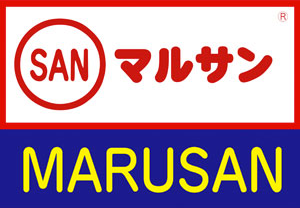
In 1923, Naokichi Ishida established Ishida Manufacturing, a company that specialized in making optical toys such as binoculars and telescopes. In 1933, his son Haruyasu took over the business and changed the name to Marusan Shoten Ltd. The company's operations were interrupted during World War II, but resumed shortly afterwards.
In 1947, Haruyasa Ishida was joined by his younger brother Minoru and their brother-in-law Yasuo Arai. Together they continued to sell optical toys as well as capitalize on the surging postwar demand for Japanese tin toys.
The Japanese toy industry discovered new frontiers in 1960 with the introduction of model kits and toys based on licensed characters. Imai released a model of giant robot from manga and anime Tetsujin 28-go (鉄人28号) that year, and shortly afterwards Nomura released a tin toy of the same character. The success of these inspired Minoru Ishida to license Godzilla from Toho Co., Ltd. (東宝株式会社), and Marusan launched a motorized model kit and a motorized tin toy of the monster in 1964.
In 1966, after learning about the science fiction TV series Ultra Q (ウルトラQ) from Tsuburaya Productions (円谷プロダクション), Marusan employee Saburo Ishizuki was inspired to create a new product line based on the kaiju in the show. Marusan was already producing soft vinyl baby dolls and cartoon animal toys, and Ishizuki felt that the material and process would be ideal for Ultra Q’s monsters.
Initially, only five kaiju were produced and in very small quantities, about 600 each. Marusan’s wholesalers and retailers were initially hesitant to take the new products. However, once the TV show aired, the figures proved to be a hit with Japanese children. Marusan would continue on to produce figures from Ultra Q and its sequel Ultraman (ウルトラマン) as well as Godzilla and his foes from the Toho kaiju films.
Marusan briefly rebranded themselves as Maruzan (マルザン) in 1967 with a lowercase "san" logo, hoping that the change would reinvigorate the company's flagging sales. Despite this, they were forced to declare bankruptcy in 1968.
Marusan's last figures produced before the bankruptcy were a series of dinosaurs from the British prehistoric adventure film One Million Years B.C. Marusan's business arrangement with Shimada Toy (島田トーイ), their primary sofubi manufacturer, allowed Shimada to use the molds if they desired. Since the dinosaur designs weren't anyone's intellectual property, Shimada took advantage of this and sold their own run of generically-packaged dinosaurs to help pay off some of Marusan's debt to them.
In 1969, former Marusan employees Kotaro Ishida, Saburo Ishizuki, and Yutaka Shibata founded the company Bullmark. Marusan’s character licenses from Toho and Tsuburaya Productions were transferred to the new company, and a similar business arrangement to Marusan's was established between Bullmark and Shimada Toy.
The same year, a new company called Marusan Co. Ltd. was established by Minoru Ishida. This new incarnation launched their own line of original kaiju designs called Marusan's Ultra Monsters. Marusan also continued to release licensed sofubi figures from tokusatsu shows such as Ultraman Ace (ウルトラマンエース).
Eventually, the second kaiju boom of the 1970s died out with the end of the Godzilla movies and Ultra Series shows, and sales of vinyl monsters went with it. By this time, Marusan had gotten heavily involved in original equipment manufacturing (OEM) work for other toy companies.
Minoru Ishida passed away in 1987, and his wife Aiko Ishida was appointed as president. In 1990, their son Kazuo Ishida became the president.
In 1997, a line of kaiju sofubi reissues was launched by Kazuo Ishida. In 2003, after Ishida's passing, Eiji Kaminaga became president of Marusan. (See the Marusan Modern tab).
In 1997, a line of kaiju sofubi reissues was launched by Marusan President Kazuo Ishida. In 2003, after Ishida's passing, Eiji Kaminaga became president of Marusan.
Marusan’s first reissue figures were from the Marusan's Ultra Monsters line. Marusan began referring to these original designs collectively as Marumon (マルモン).
The Marumon were followed up by the Dengeki Kaiju Daisakusen (電撃怪獣大作戦) series. This line included a wide variety of characters, primarily from Toho Godzilla and Daiei Gamera films. The figures themselves were mostly scaled-down versions of vintage designs with some new sculpts mixed in.
Throughout the 2000s, Marusan continued to offer a wide range of figures, both reissues and newly-sculpted designs. The TEDEROS (テデロス) line was also launched, which included robot vehicles whose designs evoked vintage tin toys alongside realistically-styled kaiju.
In the 2010s, Marusan established four new brands:
- 350 Series - Figures that measure 23 cm./9 in. tall, commonly referred to by collectors as “standard size.” These designs are a mix of straight reissues and new sculpts. The series name references the price of standard size Marusan toys in the 1960s: 350 yen.
- 450 Series - Figures that measure 30 cm./12 in. tall (or more). These designs are a mix of scaled-up versions of vintage designs and new sculpts. As with the 350 Series, the 450 Series name refers to the 1960s price of Marusan giant size toys: 450 yen.
- Marugacha - Mini-figures sold in vending machine capsules.
- Dengeki-7 - Figures that measure 18 cm./7 in. tall. These designs are a mix of scaled-down versions of vintage designs and new sculpts. They are the same size as the Dengeki Kaiju Daisakusen line from the 1990s.
Marusan’s products are currently available to purchase directly via their website and through several retailers throughout Japan. Depending on the characters licensed, some toys are available internationally while others are sold only in Japan.
Thank you to Eiji Kaminaga of Marusan for providing source material for this article 🙇🏻